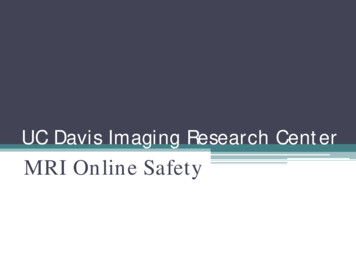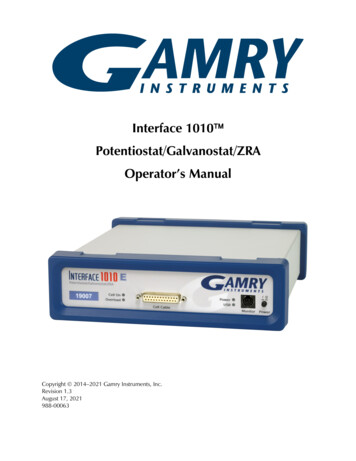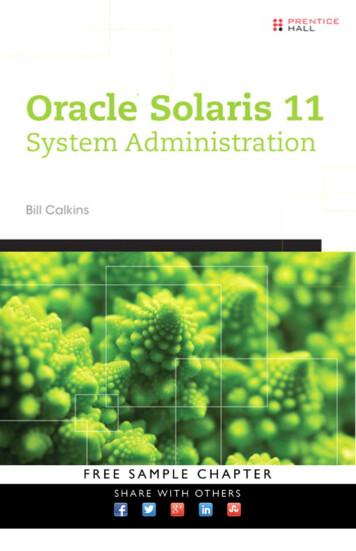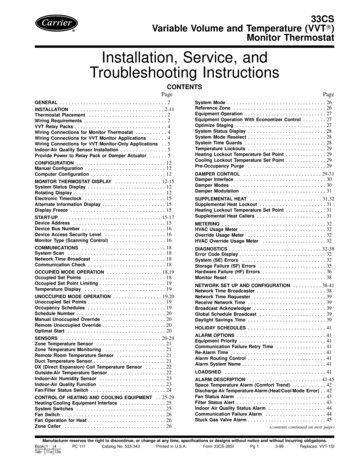
Transcription
Chapter 1010Work Zone Safety and Mobility1010.01 General1010.09 Other Traffic Control Devices or Features1010.02 Work Zone Safety and Mobility1010.10 Traffic Control Plan Development and PS&E1010.03 Transportation Management Plans and SignificantProjects1010.11 Training and Resources1010.04 Developing TMP Strategies1010.13 References1010.12 Documentation1010.05 Work Zone Capacity Analysis1010.06 Work Zone DesignExhibit 1010-1 Minimum Work Zone Clear Zone Distance1010.07 Temporary Traffic Control DevicesExhibit 1010-2 Transportation Management PlanComponents Checklist1010.08 Positive Protection Devices1010.01 GeneralAddressing work zone impacts to all road users is an important component in the design of a project and needsto be given adequate consideration early in the design process. Most work zones create some level of trafficimpacts and require additional safety features; therefore, all work areas and operations needed for constructionmust be identified and addressed during the project design. Planners, designers, construction engineers,maintenance personnel, and others all play a role in developing a comprehensive work zone design. Considerincluding Rail, Freight, and Ports, Commercial Vehicle Services, and Public Transportation Divisions for helpcoordinating with freight and transit industries. See the WSDOT Project Management website for information onproject teams.This chapter provides the designer with guidance to develop comprehensive work zone strategies and plans toaddress a project’s safety and mobility benefits/improvements for all modes, as well as constructability. Asystematic process for addressing work zone impacts is required by federal regulations and state policy.1010.02 Work Zone Safety and MobilityWashington State Department of Transportation (WSDOT) policy per Executive Order E 1001, Work Zone Safetyand Mobility, is intended to support systematic consideration and management of work zone impacts across allstages of project development.The policy states:All WSDOT employees are directed to make the safety of workers and the traveling public ourhighest priority during roadway design, construction, maintenance, and related activities.Designers should be familiar with this document. The policy defines how WSDOT programs address work zonesafety and mobility issues during project planning, design, and construction.1010.03 Transportation Management Plans and Significant Projects1010.03(1) Transportation Management Plan (TMP)A transportation management plan is a set of strategies such as Transportation Systems Management andOperations (TSMO) strategies (such as dynamic lane merge, dynamic speed control, or Smart Work ZoneSystems) for managing the corridor-wide work zone impacts of a project. A TMP is required for all projects and isthe key element in addressing all work zone safety and mobility impacts. The TMP development begins in theWSDOT Design Manual M 22-01.20September 2021Page 1010-1
Chapter 1010Work Zone Safety and Mobilityscoping phase of a project by assessing impacts known at the time and then selecting mitigating strategies anddesign solutions to manage those impacts. It is very important to continue the development of the TMPthroughout the project development process.Not all work zone impacts have to be addressed with traffic control plans only. Many work zone impacts can bereduced or eliminated through project design elements like alignment choice, materials selection, structuretypes, overbuilding, and phased construction. Work zone impacts related to work duration may be resolved orreduced through innovative bidding and contract administration.A TMP may recommend temporary modification to design elements outside the ranges discussed in the DesignManual.For example, a work zone may temporarily reduce design speed and/or lane and shoulder widths. Thesetemporary design elements are documented in the TMP and in the project’s work zone traffic control plans andcontract provisions. They do not require a Design Analysis.The three major components of a TMP are described below.1010.03(1)(a) Temporary Traffic ControlTemporary Traffic Control (TTC) components are those strategies for directing traffic through the work zone andminimizing the duration of the impacts. These components are to be included in the Plans, Specifications, andEstimates (PS&E) as Traffic Control Plans (TCPs) and contract provisions. The TTC components may include butare not limited to the following strategies: TTC strategies such as lane closures or shifts, one-lane two-way operations (flagging and or pilot car),staged construction, or full road closures and detours.Traffic Control Devices such as temporary signing, channelizing devices (cones, drums), changeablemessage signs, arrow boards, temporary signals, and temporary pavement markings.Corridor Project Coordination, Contracting Strategies, and Innovative Construction Strategies such asA B bidding, incentives/disincentives, and precast members or rapid cure materials.WSDOT Design Manual M 22-01.20September 2021Page 1010-2
Chapter 1010Work Zone Safety and Mobility1010.03(1)(b) Transportation Systems Management and Operations (TSMO)The TSMO components are those strategies for improving traffic flow and safety through the work zone. Someof these strategies may be included in the PS&E, but could also be WSDOT-managed elements outside thecontract. The TSMO components may include but are not limited to the following strategies: Transportation demand management strategies such as Transit service improvements, transitincentives, and park & ride promotion.Corridor/Network Management (traffic operations) Strategies such as Signal timing/coordinationimprovements, temporary signals, bus pullouts, reversible lanes, and truck/heavy-vehicle restrictions.Work Zone Safety Management Strategies such as using positive protective devices, speed limitreductions, automated flagger assistance devices, radar speed display signs.Traffic/Incident Management and Enforcement Strategies such as Traffic Management Centers (TMCs)and Intelligent Transportation Systems (ITS), Washington State Patrol, tow service, WSDOT IncidentResponse Team vehicle(s), traffic screens, and emergency pullouts in long work zones with narrowedshoulders.Smart Work Zone Systems and simpler version, Queue Warning Systems are dedicated specialized smartsystems to provide more rapid information to drivers and to optimize the safety and efficiency of trafficthrough the work zone.1010.03(1)(c) Public InformationThe Public Information (PI) components are those strategies for raising awareness of the upcoming projectimpacts or current restrictions. Public awareness strategies may be developed and implemented by WSDOTthrough the region or Headquarters (HQ) Communications offices and implemented before and duringconstruction. Motorist information strategies may be WSDOT-managed elements with state equipment outsidethe contract or identified on plans in the PS&E. The PI components may include, but are not limited to, thefollowing strategies: Public Awareness Strategies such as Brochures or mailers, press releases, paid advertisements, andproject website (consider providing information in other languages if appropriate).Motorist Information Strategies such as Highway advisory radio (HAR), changeable message signs, andtransportation management center (TMC).It is very important to continue the development of the TMP throughout the project development process. Notall work zone impacts have to be addressed with traffic control plans only. Many work zone impacts can bereduced or eliminated through project design elements like alignment choice, materials selection, structuretypes, overbuilding, and phased construction. Work zone impacts related to work duration may be resolved orreduced through innovative bidding and contract administration.The TMP Checklist in Exhibit 1010-2 will help identify and organize TMP components. Include the completedchecklist in the Project File. For significant projects, develop this checklist and the supporting plans, data,impacts assessment, strategies, capacity/delay analysis and endorsements into a formal TMP document to beincluded in the Project File. For TMP examples, see:www.ops.fhwa.dot.gov/wz/resources/final rule/tmp examples/sample ions/trans mgmt plans/trans mgmt plans.pdfWSDOT Design Manual M 22-01.20September 2021Page 1010-3
Chapter 1010Work Zone Safety and Mobility1010.03(2) Significant ProjectsThe FHWA definition of a “significant project” is as follows:A significant project is one that, alone or in combination with other concurrent projectsnearby, is anticipated to cause sustained work zone impacts that are greater than what isconsidered tolerable based on state policy and/or engineering judgment.All Interstate system projects within the boundaries of a designated TransportationManagement Area (TMA) that occupy a location for more than three days with eitherintermittent or continuous lane closures shall be considered as significant projects.Note: Significant projects require a TMP document addressing safety and mobility impacts with strategies orelements from all three TMP components.The size and scale of the TMP document will depend on the project’s complexity and impacts. For examples ofWSDOT TMP’s see: topics/traffic-work-zone-traffic-controlwztcFor projects not identified as significant, the Temporary Traffic Control components included in the PS&E will beconsidered the TMP. Transportation Systems Management and Operations and Public Information componentsmay also be required to properly address the impacts as many projects can have significant work zone safetyand mobility impacts, but are not necessarily a significant project as defined under the federal requirementsstated above. Consider developing a TMP document for these types of projects as well.The Project Summary must include a Work Zone Strategy Statement and indicate whether the project issignificant in regard to work zone impacts.Significant projects may require a Value Engineering (VE) study (see Chapter 310) and a Cost Risk Assessment(CRA) or Cost Estimate Validation Process (CEVP) that could help define strategies or identify sessment/1010.04 Developing TMP Strategies1010.04(1) Key ConsiderationsThe following list is intended to alert the designer to actions and issues that need to be addressed as part of aTMP. Addressing these items is required per WSDOT’s work zone policy and federal regulations, and they arekey to the successful development of a project’s TMP. Determine work zone impacts through an impact assessment process.Minimize, mitigate, and manage work zone impacts.Integrate work zone impacts strategies early, during planning, programming, and design.Develop an accurate scoping estimate based on the work zone strategies.Hold a Work Zone Design Strategy Conference early in the design process. (Include bridge, construction,traffic, maintenance, freight, transit, local agency, and law enforcement personnel.)Utilize the Work Zone TMP Checklist/TMP document (required for significant projects).Emphasize flagger safety.Assess work zone mobility through a capacity analysis.Integrate project constructability, work efficiency and cost containment into the work zone strategy.Attend work zone training.Address Washington State traffic and safety regulations as provided for by state law.WSDOT Design Manual M 22-01.20September 2021Page 1010-4
Chapter 1010 Work Zone Safety and MobilityUse the legally adopted Manual on Uniform Traffic Control Devices (MUTCD), with Washington Statemodifications as the minimum standard.Provide an appropriate level of traffic control plans (TCPs).Consider work zone ITS elements.Use established design criteria in work zone roadway and roadside design.Accommodate pedestrian access (including ADA requirements) and maintenance of existing transit stopsand bicycle traffic.Consider maintenance issues and needs through the duration of the project.Consider school, hospital, emergency services, and postal delivery, impacts.Consider economic impacts (business access) due to traffic delay or restricted access.Consider freight mobility; total roadway widths to less than 16 feet should be avoided if possible. Truckroutes can be found here: ation-plansAddress traffic impacts extending beyond the project limits and impacting other roads.Identify seasonal or special event impacts that affect recreation or business due to work zone impacts.Consider risk management and tort liability exposure.Approach the work zone design from the road user’s perspective.Incorporate worker safety needs (positive protection) in your work zone designs.Account for all needed work areas, operations and possible staging areas.Address work vehicle ingress and egress to each work area.Use of law enforcement1010.04(2) Impacts AssessmentOne of the most important tasks in developing a TMP is assessing all of the project impacts to mobility andsafety. Impacts that are not identified and addressed in the TMP will undoubtedly become issues during theconstruction phase of the project. A designer needs to possess a clear understanding of how project featureswill be constructed, including work methods, equipment, materials, and duration, to complete the work. Involvethe construction PE when making decisions on assessing and addressing impacts.A complete and accurate impacts assessment will allow for the development of an effective TMP that shouldonly need minor modifications to address construction issues. The Traffic Manual provides information on howto determine expected work zone congestion along with mobility management strategies.An early and ongoing impacts assessment allows time to: Develop TTC, TSMO, and PI (see Section 1010.03(1)) strategies to address identified impacts as neededto effectively manage the project.Resolve potential work zone impacts within the design features of the project. Decisions that considerwork zone impacts during bridge type selection, materials selection, advertisement dates, and othershave the potential to resolve or minimize work zone impacts.Consider innovative mitigation strategies that may involve many stakeholders.Some impacts may be difficult to completely solve and may ultimately need a management decision todetermine the level of mitigation or impact that is acceptable. These types of impacts need to be clearlyaddressed in the TMP with documentation supporting and explaining the decision.WSDOT Design Manual M 22-01.20September 2021Page 1010-5
Chapter 1010Work Zone Safety and MobilityThe following are some examples of impacts that need to be managed during the design of a project:1. Bridge construction sequence or falsework opening plans need to match the TTC staging orchannelization plans. Coordination with the HQ Bridge and Structures Office is essential as thebridge design schedule may differ than the project schedule. Maintain the legal height of 16 feet 6inches as the minimum falsework opening whenever possible; anything less than this must consideroverheight vehicle impacts, possible additional signing needs, and temporary bypass routes. Impactsto shoulder widths due to barrier or bridge staging may impact bicycle or pedestrian access andmust be addressed in TTC plans. Refer to Chapter 720 for additional requirements and approvals.Coordination with the Permits Office may be needed.2. If existing signal and illumination systems are not able to be maintained during the constructionphases, plans for temporary systems or connections need to be included in the project.3. Temporary relocation of existing signing (including overhead signing) may be required and should bedetailed in the plans.4. Permanent traffic loop installation (such as advance loops, turn pockets, and stop bars, and ITSloops) and pavement marking installations (crosswalks, arrows, and so on) may require specific TTCplans.5. What type of temporary marking is most appropriate for the installation, work duration, and thepavement surface? Will the final pavement surface have a “ghost stripe” potential?6. Lane shifts onto existing shoulders:o Is the depth of the existing shoulder adequate to carry the extra traffic and are there rumblestripe that need to be removed?o Are there any existing catch basins or junction boxes located in the shoulder that cannotaccept traffic loads over them?o What is the existing side slope rate? If steeper than 4H:1V, does it need mitigation? Arethere existing roadside objects that, when the roadway is shifted, are now within the clearzone limits?o Shifting of more than one lane in a direction is only allowed with temporary pavementmarkings. Shifting lanes by using channelizing devices is not allowed due to the highprobability that devices used to separate the traffic will be displaced.o Signal head alignment: When the lane is shifted approaching the intersection, is the signalhead alignment within appropriate limits?7. Roundabout construction at an existing intersection requires site-specific staging plans.Roundabouts create many unique construction challenges and each roundabout has very sitespecific design features.1010.04(3) Work DurationThe duration of work is a major factor in determining a strategy and the amount and types of devices to use intraffic control work zones. A project may have work operations with durations that meet several or all of thefollowing conditions:1010.04(3)(a) Long-Term Stationary Work ZoneThis is work that occupies a location continuously for more than three days. Construction signs should be postmounted and larger; more stable channelizing devices should be used for increased visibility. Temporarybarriers, pavement markings, illumination, and other considerations may be required for long-term stationarywork. Staged construction or temporary alignment/channelization plans are required with this type of work.WSDOT Design Manual M 22-01.20September 2021Page 1010-6
Chapter 1010Work Zone Safety and Mobility1010.04(3)(b) Intermediate-Term Stationary Work ZoneThis is work that occupies a location for up to three days. Signs may still be post-mounted if in placecontinuously. Temporary pavement markings, in addition to channelization devices, may be required for laneshifts. Barrier and temporary illumination would normally not be used in this work zone duration.1010.04(3)(c) Short-Term Stationary Work ZoneThis is work that occupies a location for more than one hour within a single day. At these locations, all devicesare placed and removed during the single period.1010.04(3)(d) Short-Duration Work ZoneThis is work that occupies a location for up to one hour. Because the work time is short, the impact to motoristsis usually not significant. Simplified traffic control set-ups are allowed, to reduce worker exposure to traffic. Thetime it may take to set up a full complement of signs and devices could approach or exceed the amount of timerequired to perform the work. Short-duration work zones usually apply to maintenance work and are not usedon construction projects. (See Work Zone Traffic Control Guidelines for more information.)1010.04(3)(e) Mobile Work ZoneThis is work that moves intermittently or continuously. These operations often involve frequent stops foractivities such as sweeping, paint striping, litter cleanup, pothole patching, or utility operations, and they aresimilar to short-duration work zones. Truck-mounted attenuators, warning signs, flashing vehicle lights, flags,and channelizing devices are used, and they move along with the work. When the operation moves along theroad at low speeds without stopping, the advance warning devices are often attached to mobile units and movewith the operation.Pavement milling and paving activities are similar to mobile operations in that they can progress along aroadway several miles in a day. These operations, however, are not considered mobile work zones, and workzone traffic control consistent with construction operations is required.1010.04(4) Transportation Management Plan StrategiesWith a completed impacts assessment, strategy development can begin. There are often several strategies toaddress a work zone impact, and engineering judgment will be needed in selecting the best option.Constructability, along with addressing safety and mobility, is the goal. Selecting a strategy is often acompromise and involves many engineering and non-engineering factors. Work closely with bridge,construction, maintenance and traffic office personnel when selecting and developing strategies for theTransportation Management Plan (TMP) and PS&E.Do not assume that strategies chosen for past projects will adequately address the impacts for similar currentprojects. There may be similarities with the type of work, but each project is unique and is to be approached inthat manner. Always look for other options or innovative approaches; many projects have unique features thatcan be turned to an advantage if carefully considered. Even a basic paving project on a rural two-lane highwaymay have opportunities for detours, shifting traffic, or other strategies.The Traffic Manual contains comprehensive information regarding work zone traffic analysis to determineexpected delay and queuing.For a list of work zone analysis tools, see: http://ops.fhwa.dot.gov/wz/traffic analysis/index.htm#toolsWSDOT Design Manual M 22-01.20September 2021Page 1010-7
Chapter 1010Work Zone Safety and Mobility1010.04(5) Temporary Traffic Control Strategies1010.04(5)(a) Lane ClosureWhen one or more traffic lanes are closed, a capacity analysis is necessary to determine the extent ofcongestion that may result. Night work or peak hour work restrictions may be required if the analysis showsadverse traffic impacts. On highways with speeds over 40 MPH, traffic safety drums and truck-mountedattenuators should be used in lane closures and the drums should not encroach on the open lanes. Additionallanes should be closed if encroachment is necessary. Consider closing additional lanes to increase the lateralbuffer space for worker safety.1010.04(5)(b) Shoulder ClosureA shoulder closure is used for work areas off the traveled way. On high-volume freeways or expressways, theyshould not be allowed during peak traffic hours. Channelization devices should not encroach on the open lanesof roadways with speeds of 45 mph and above.1010.04(5)(c) Alternating One-Lane Two-Way TrafficThis strategy involves using one lane for both directions of traffic. Flaggers are used to alternate the trafficmovements.If flaggers are used at an intersection, a flagger is required for each leg of the intersection. Only lawenforcement personnel are allowed to flag from the center of an intersection. Close lanes and turn pockets soonly one lane of traffic approaches a flagger station. When a signal is present, it shall be turned off or set to redflash mode when flagging.Law enforcement personnel may be considered for some flagging operations and can be very effective whereadditional driver compliance is desired. The Traffic Manual contains information on the use of law enforcementpersonnel at work zones.Flagger safety is a high emphasis area. Do not include alternating traffic with flaggers as a traffic control strategyuntil all other reasonable means of traffic control have been considered. Flagging stations need to beilluminated at night. Flaggers need escape routes in case of errant vehicles. Provide a method of alerting themto vehicles approaching from behind. Two-way radios or cellular phones are required to allow flaggers tocommunicate with one another. The flagger’s location, escape route, protection, signing, and any other safetyrelated issues all need to be incorporated into the traffic control plan for the flagging operation. Flaggers are notto be used on freeways or expressways. Using flaggers solely to instruct motorists to proceed slowly is anunacceptable practice.Removing flaggers from the roadway during alternating traffic operations can be done with portable temporarytraffic control signals or automated flagging assistance devices (AFAD). Portable signals work best when thelength between signals will be 1,500 feet maximum and no accesses lie between the temporary signals. EachAFAD unit will need a flagger operating the device from a safe location off the roadway. A traffic control planshould show the advance signing and the AFAD or signal locations. Temporary stop bars, and lighting at the stopbars is required for signal use. For assistance on using these devices, contact the region Traffic Office.Refer to WAC 296-155-305 for flagging requirements.WSDOT Design Manual M 22-01.20September 2021Page 1010-8
Chapter 1010Work Zone Safety and Mobility1010.04(5)(d) Temporary Alignment and ChannelizationTemporary alignments and/or channelization may be an option for long-term work zones or staged trafficcontrol. The following are guiding principles for the design of temporary alignment and channelization plans: Use site-specific base data to develop site-specific traffic control plans.Use permanent geometric design criteria.Provide beginning and ending station ties and curve data.Include lane and shoulder widths.Provide temporary roadway sections.To avoid confusion, do not show existing conflicting or unnecessary details on the plan.Do not use straight line tapers through curves; use circular alignment.Be aware of existing crown points, lane/shoulder cross slope breaks, and super-elevation transitions thatmay affect a driver’s ability to maintain control of a vehicle.If the project has multiple stages, from one stage to the next, show newly constructed features asexisting elements. For example, if an edge line is removed in one stage, the following stage would showthe change by indicating where the new edge line is located.Consider the time needed for removal of existing markings and placement of the new markings andpossibly placement of barriers and attenuators. In urban areas where work hours for lane closures arelimited, special consideration may be necessary to allow time to implement the plan, or an interim stagemay be necessary.Use shoulder closure signing and channelizing devices to close a shoulder prior to a temporary impactattenuator and run of temporary concrete barrier.Existing signing may need to be covered or revised, and additional construction warning signs may beneeded for the new alignment.Temporary pavement marking types and colors should be specified. Long-duration temporary markingsshould be installed per the Standard Plans for permanent markings.For better guidance through shifting or taper areas, consider solid lane lines. Return to broken lane linesbetween shift areas.Provide a list of the approved temporary impact attenuators that may be used for the plan if applicable.The plans must provide all the layout information for all the temporary features just as a permanentpavement marking plan would.i Staged ConstructionStaged construction entails combining multiple work areas into a logical order to provide large protectedwork areas for long durations, which maximizes work operations and minimizes daily impacts to traffic.Temporary alignment and channelization plans must be designed to place traffic in these semi-permanentlocations. Minimum geometric design criteria are to be used when developing these plans. Designstrategies such as overbuilding for future stages or the use of temporary structures are often part ofstaged construction on significant impact projects or mega projects. Develop detailed capacity analysisand traffic modeling for each stage.WSDOT Design Manual M 22-01.20September 2021Page 1010-9
Chapter 1010Work Zone Safety and Mobilityii Lane Shift/Reduced Lane WidthTraffic lanes may be shifted and/or width-reduced in order to accommodate a long-duration work areawhen it is not practicable, for capacity reasons, to reduce the number of available lanes. Shifting morethan one lane of traffic requires the removal of conflicting pavement markings and the installation oftemporary markings; the use of channelization devices to delineate multiple lanes of traffic is not allowed.Use advanced warning signs to show the changed alignment when the lateral shifting distance is greaterthan one-half of a lane width, and consider the use of solid lane lines through the shift areas.Utilizing the existing shoulder may be necessary to accommodate the shifting movement. First, determinethe structural capacity of the shoulder to ensure its ability to carry the proposed traffic. Remove and inlayexisting shoulder rumble strips prior to routing traffic onto the shoulder.iii Traffic Split or Island Work ZoneThis strategy separates lanes of traffic traveling in one direction around a work area. On higher-speedroadways, temporary barriers are provided to prevent errant vehicles from entering the work area. Somedrivers have difficulty understanding "lane split" configurations, which sometimes results in poor drivingdecisions such as unnecessary or late lane changes. Braking and erratic lane changes decrease the trafficcapacity through the work zone, which results in an unstable traffic flow approaching the lane split.Evaluate other strategies, such as overbuilding, to keep traffic on one side of the work area to avoid atraffic split if possible.Consider the following guidance for traffic split operations: Define the work operation and develop the traffic control strategy around the specificoperation.Limit the duration the traffic split can be in place. Consider incentives and disincentives toencourage the contractor to be as efficient as possible. A higher level of traffic impacts may beaccep
Chapter 1010 Work Zone Safety and Mobility 1010.01 General . (WSDOT) policy per Executive Order E 1001, Work Zone Safety and Mobility, is intended to support systematic consideration and management of work zone impacts across all . Management Area (TMA) that occupy a location for more than three days with either .










